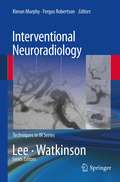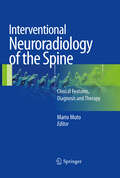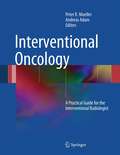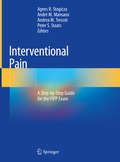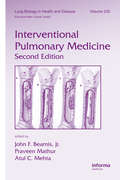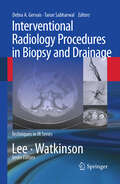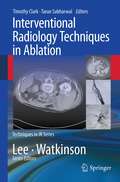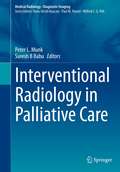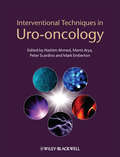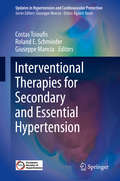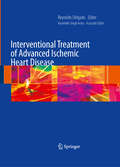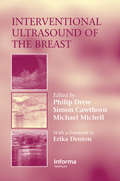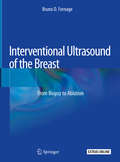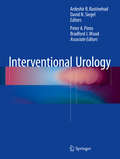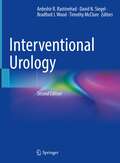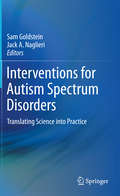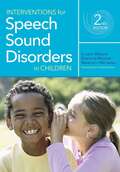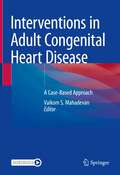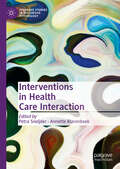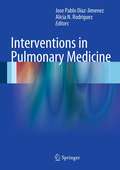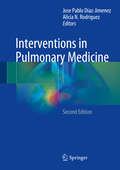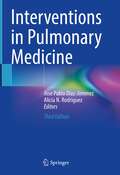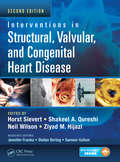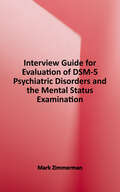- Table View
- List View
Interventional Neuroradiology
by Kieran Murphy Fergus RobertsonInterventional radiology has seen a dramatic increase in the number of minimally invasive therapies performed. Interventional radiology treatments now play a major role in many disease processes and continues to grow with new procedures added to the armamentarium of the interventional radiologist, almost on a yearly basis. There are many textbooks which are disease specific, which incorporate interventional radiology techniques. These books are important to understand the natural history, epidemiology, pathophysiology and diagnosis of disease processes. However, a detailed handbook that describes the technique of performing the various interventional radiology procedures is a useful addition to have in the Cath Lab, where information can be accessed easily before, during or even after a case. This technique-specific book is primarily of benefit to those in training in general radiology and more specifically for Residents and Fellows who are training in interventional radiology and who may be taking subspeciality certificate examinations in interventional radiology. In addition, this book will be of help to most practicing interventional radiologists, be they be in academic or private practice. This is the kind of book that can be left in the interventional lab and will be of benefit to ancillary staff, such as technicians/radiographers or nurses who are specialising in the care of patients referred to interventional radiology. This volume on neurointervention will enhance the series by expounding on the specific techniques required when working on conditions of the head, neck and spine.
Interventional Neuroradiology of the Spine
by Mario MutoAccurate interpretation of indications for treatment is the cornerstone of success in medicine. This book carefully examines the relation between clinical features, diagnosis, and choice of minimally invasive technique for a range of spine pathologies. It explains how selection of technique is intimately related to clinical and diagnostic aspects and how recognition of this relation forms the foundation for an optimal outcome. In addition to examining the various minimally invasive options, including the latest techniques, careful attention is paid to the role of medical treatment in avoiding recurrence after initial therapy. Nerve blocks, epidural injections, and intradiscal procedures are among the many options available in the armamentarium of the interventionalist, and advice is given on their use in different contexts. This volume will be of great value for neuroradiologists and others responsible for treating patients with spine disorders.
Interventional Oncology
by Andreas Adam Peter MuellerInterventional Oncology is a fast-growing new field, as well as an emerging specialty. Many minimally-invasive, imaging-guided procedures seem set to replace more traditional open surgical techniques of treating solid tumors in a variety of organs. The aim of this book is to describe new interventional radiological methods in a succinct and practical form. Diagnostic radiological considerations relevant to the selection and follow-up of patients are also covered. The book begins with an overview of the basic principles of current interventional techniques, including thermal ablation, high intensity focused ultrasound, and embolization. Later chapters focus on tumors of the liver, kidney, lung, and bone, placing new interventional techniques in context by referring to the surgical and oncologic methods of treating the same conditions. With an emphasis on best practices, Interventional Oncology: A Practical Guide for the Interventional Radiologist will serve as a definitive guide to practicing physicians involved in this rapidly evolving field.
Interventional Oncology
by Jean-Francois H. Geschwind Michael C. SoulenInterventional oncology has joined surgical, radiation, and medical oncology as the fourth pillar of cancer care. Advances in imaging and image guidance for the detection, characterization, targeting, and therapy of cancer now allow for minimally invasive image-guided treatment of many solid tumors without the morbidity of open surgery or the toxicity of chemotherapy and radiation. The editors have brought together the accrued experience of pioneers and leaders in image-guided cancer therapy from around the globe to create the first comprehensive text for this emerging field. Covering the biology, techniques, clinical applications, and outcomes of interventional oncologic procedures for the treatment and palliation of solid tumors throughout the body, this practical reference will be indispensable for physicians across specialties who seek to provide collaborative, leading-edge care to cancer patients.
Interventional Pain: A Step-by-Step Guide for the FIPP Exam
by Peter S. Staats Andrea M. Trescot Agnes R. Stogicza André M. MansanoThis comprehensive book serves as a review for the Fellow of Interventional Pain Practice (FIPP) exam and functions as a concise guide for all interventional pain doctors. Through educational initiatives, it helps to promote consensus-building among experts on the effectiveness of existing techniques and avenues for advancement of therapeutic performances.The book is divided into four sections (head and neck, thoracic, lumbar and sacral/pelvic), and each chapter is devoted to the safe, standardized approach to interventional procedures. To prepare both the examiner and the examinee for the FIPP examination, each chapter contains the relevant C-arm images and outlines the most common reasons for “unacceptable procedures performance” and “potentially unsafe procedures performance.” Distinguishing it from many of the previous guides, it also includes labeled fluoroscopic high quality images and focuses on the current FIPP-examined procedures with all accepted approaches.Written and edited by world leaders in pain, Interventional Pain guides the reader in study for FIPP Exam and offers a consensus on how interventional procedures should be performed and examined.
Interventional Pulmonary Medicine
by Atul C. Mehta John F. Beamis Praveen MathurWritten by skilled specialists in the field of interventional pulmonology, the new Second Edition thoroughly explores the latest advancements, newest therapies, and diagnostic techniques in interventional pulmonary medicine. Using guidelines to ensure maximum quality and efficiency in patient care, this concise text is a must-have resource for all
Interventional Radiology Procedures in Biopsy and Drainage
by Tarun Sabharwal Debra A. GervaisThe Techniques in Interventional Radiology series of handbooks describes in detail the various interventional radiology procedures and therapies that are in current practice. The series comprises four titles, which in turn cover procedures in angioplasty and stenting, transcatheter embolization and therapy, biopsy and drainage and ablation. Forthcoming are volumes on pediatric interventional radiology and neurointerventional radiology. Each book is laid out in bullet point format, so that the desired information can be located quickly and easily. Interventional radiologists at all stages, from trainees through to specialists, will find this book a valuable asset for their practice. Interventional Radiology Procedures in Biopsy and Drainage presents the full array of operations using these techniques. The book is split into two sections - one dedicated to biopsy procedures and the other to drainage procedures. Dr. Debra Gervais is Director of Pediatric Imaging and Associate Director of Abdominal Imaging and Intervention at Massachusetts General Hospital, Boston, Massachusetts, USA. Dr. Tarun Sabharwal is a Consultant Interventional Radiologist at Guy's and St Thomas' Hospital, London, UK.
Interventional Radiology Techniques in Ablation
by Timothy Clark Tarun SabharwalThe Techniques in Interventional Radiology series of handbooks describes in detail the various interventional radiology procedures and therapies that are in current practice. The series comprises a number of titles, which cover procedures in angioplasty and stenting, transcatheter embolization and therapy, biopsy and drainage, ablation, pediatric interventional radiology and neurointerventional radiology. Each book is laid out in bullet point format, so that the desired information can be located quickly and easily. Interventional radiologists at all stages, from trainees through to specialists, will find this book a valuable asset for their practice. Interventional Radiology Techniques in Ablation is a practical and concise guide to contemporary techniques in image-guided tumor ablation. This handbook is intended to serve as a quick reference for physicians in interventional radiology training as well as a resource for IR technologists, nurses, nurse practitioners and physician assistants.
Interventional Radiology in Palliative Care (Medical Radiology)
by Peter L. Munk Suresh B BabuThis important book fills a gap in the literature by focusing specifically on the role of interventional radiology in patients receiving palliative medicine and supportive care, a group in which the need for minimally invasive therapy is especially high. Detailed information and guidance is provided on use of the tools of interventional radiology for the purpose of problem solving in relation to a wide variety of diseases and complications. Readers will find clear explanation of the ways in which interventional radiology techniques can assist with regard to intravenous access, feeding, musculoskeletal and neurological pain relief, tumor debulking, management of bleeding and obstructions, drainages, and treatment of fistulas. Throughout, helpful tips and tricks of value in daily practice are highlighted. The book is an ideal reference on the interventional management of palliative/supportive care and the effective use of interventional radiology techniques in a multidisciplinary environment. Beyond specialists and trainees in interventional radiology, it will have broad appeal to all who deal with patients on palliative and supportive care on a day-to-day basis.
Interventional Techniques in Uro-oncology
by Manit Arya Peter T. Scardino Hashim Uddin Ahmed Mark EmbertonMinimally invasive surgical techniques are moving into the mainstream of urological practice. Even less invasive techniques, some of which can involve no use of the knife whatsoever, are rapidly being developed and implemented for treating urological cancer. Interventional Techniques in Uro-oncology is the first text to cover these techniques in total and provides a comprehensive review of the state-of-the-art minimally invasive interventions. This well-illustrated reference provides the basic science behind each technique before explaining when and how best to perform them. It examines their use in different clinical settings, the advantages and disadvantages of each technique in the management of specific tumor types, and their suitability for different patients. Future techniques are discussed including the potential of nanotechnology in the delivery of urologic healthcare. Each chapter is easy to navigate with key points and references. Interventional Techniques in Uro-oncology is an essential reference for training and practicing oncologists, urologists and radiologists as well as the general physician with a keen interest in cancer care. Its approachable style will also inform non-experts on what is available and whether a particular intervention is suitable for their patient in the clinic.
Interventional Therapies for Secondary and Essential Hypertension
by Giuseppe Mancia Costas Tsioufis Roland E. SchmiederThis book aims to describe the role of interventional therapies in various forms of secondary hypertension and to explain the ability of such approaches to address unmet needs in the setting of uncontrolled essential hypertension. The coverage encompasses interventions in the full range of relevant conditions, including the various specific pathologies responsible for secondary hypertension, such as renal artery stenosis, coarctation of the aorta, and adrenal tumors. In each case, up-to-date information is presented on indications, procedural aspects, and patient follow-up. A further focus is the most recent knowledge on the use of invasive neuromodulation, such as renal sympathetic denervation and baroreflex stimulation. The text is supplemented by helpful explanatory diagrams and treatment algorithms. A comprehensive clinical guide of this nature has to date been absent from the literature. The book will be of interest to clinicians managing hypertensive patients, researchers investigating advanced hypertension management, and students on cardiovascular courses.
Interventional Treatment of Advanced Ischemic Heart Disease
by Reynolds Delgado Harvinder Singh AroraAdvanced ischemic heart disease is fast becoming one of the most challenging problems facing the modern cardiovascular physician and current established therapies often fail to adequately address this population of patients. As therapy of heart disease evolves, we need to address the challenging questions posed by this clinical problem. Treatment of Advanced Ischemic Heart Disease brings together the most recent advances in surgical techniques, protection of the heart and postoperative care, to aid the study and treatment of these patients who deserve the best that modern medicine can provide them. The diagnosis and treatment of coronary artery disease and heart failure has now been standardized to the point that there are very well established guidelines promoted by the American Heart Association and The American College of Cardiology. This text will pick up where the guidelines leave off and address the real challenge of patients with advanced ischemic heart disease. Though therapy is clearly challenging, new advances are making effective therapy of these patients truly possible. This text embodies that notion. Finally, there is much still to learn about the basic mechanisms of the progression of heart failure due to coronary artery disease and how best to assess these therapeutic options. The text will address these with a focus on treatment so that it may be a practical reference for the practicing clinician as well as the basic or clinical researcher and student.
Interventional Ultrasound of the Breast
by Michael Michell Philip Drew Simon CawthornOver the past decade interventional radiology techniques have replaced surgical and clinically guided diagnostic procedures such that the vast majority of patients have a non surgical diagnosis of a breast problem. Interventional Ultrasound of the Breast, written by a collection of well-established and respected authors from the UK's leading cancer
Interventional Ultrasound of the Breast: From Biopsy to Ablation
by Bruno D. FornageThis book is the premier guide to ultrasound-guided interventions of the breast. Written by Bruno D Fornage, a world-renowned leader in the fields of breast ultrasound and ultrasound-guided interventions, it covers in detail techniques of freehand ultrasound-guided breast biopsy, placement of post-biopsy markers, localization of nonpalpable lesions, and percutaneous ablation of breast masses. A large part of the book describes the highly effective combined use of fine-needle aspiration and core-needle biopsy during the staging of breast cancer; this combination has been used successfully by the author at MD Anderson Cancer Center for 3 decades. Throughout the book, the author shares numerous tips and tricks, many of which have not been published before. With over 1300 figures and and 200 videoclips depicting ultrasound-guided procedures, Interventional Ultrasound of the Breast is the authoritative resource for breast imagers, interventional radiologists, surgical breast oncologists, pathologists, and anyone who embarks on ultrasound-guided breast biopsies and other breast procedures. In addition, the techniques described in this book are applicable to many other areas of the body, including the thyroid and soft tissues.
Interventional Urology
by Ardeshir R. Rastinehad David N. Siegel Peter A. Pinto Bradford J. WoodThis book provides a concise yet comprehensive summary of the evolving techniques and current status of interventional urology. The book is organized by organ system with subtopics covering imaging technologies, interventional techniques, and clinical outcomes for the vast variety of interventional urologic procedures. It represents the first single text covering these topics and will help guide patient management and stimulate investigative efforts. Written by experts in the field, Interventional Urology provides a richly illustrated, image-guided, state-of-the art review of this new field, that will serve as a valuable resource for clinicians, interventional urologists, interventional radiologists, researchers, and residents with an interest in interventional urology.
Interventional Urology
by Ardeshir R. Rastinehad David N. Siegel Bradford J. Wood Timothy McClureThis updated text provides a concise yet comprehensive and state-of-the-art review of evolving techniques in the new and exciting subspecialty of interventional urology. Significant advances in imaging technologies, diagnostic tools, fusion navigation, and minimally invasive image-guided therapies such as focal ablative therapies have expanded the interventional urologists’ clinical toolkit over the past decade. Organized by organ system with subtopics covering imaging technologies, interventional techniques, recipes for successful practice, pitfalls to shorten the learning curves for new technologies, and clinical outcomes for the vast variety of interventional urologic procedures, this second edition includes many more medical images as well as helpful graphics and reference illustrations. The second edition of Interventional Urology serves as a valuable resource for clinicians, interventional urologists, interventional radiologists, interventional oncologists, urologic oncologists, as well as scientists, researchers, students, and residents with an interest in interventional urology.
Interventions for Autism Spectrum Disorders
by Sam Goldstein Jack A. NaglieriChildren are being diagnosed with autism spectrum disorders at a staggering rate--as many as one in 110, according to some studies. To this sobering statistic add the familiar figures of the toddler disengaged from his peers, the middle schooler shunned in the lunchroom, and the adult struggling with social cues on the job, and professionals are faced with a mounting challenge: to assist and support young people with these disorders to ensure their successful transition to adolescence and adulthood. The first volume dedicated solely to its topic, Interventions for Autism Spectrum Disorders provides a comprehensive overview of programs currently in use. Contributors explore programs focusing on long-term outcomes, home- and classroom-based strategies, resilience training for parents, and pharmacological management of symptoms. Background chapters review issues in reliability and validity of interventions and evaluating treatment effectiveness. And an especially cogent chapter discusses the centrality of treatment integrity to best practice. Comprehensive programs and targeted interventions covered include: The Early Start Denver Model for young children.The TEACCH program for children, adults, and families.The Center for Autism and Related Disorders (CARD) and CARD eLearning.PROGress: a program for remediating and expanding social skills.Evidence-based strategies for repetitive behaviors and sensory issues.Self-regulation strategies for students with autism spectrum disorders.Interventions for Autism Spectrum Disorders is an essential resource for researchers, professionals/practitioners, and clinicians in a wide array of fields, including clinical child, school, and developmental psychology; child and adolescent psychiatry; education; rehabilitation medicine/therapy; social work; and pediatrics.
Interventions for Speech Sound Disorders in Children
by Gail T. Gillon Joy Stackhouse Barbara Dodd Caroline Bowen Stephen Camarata Amy Clark Michelle Pascoe Rebecca J. McCauley Sharynne McLeod Alan Kamhi Kirrie J. Ballard Barbara May Bernhardt Francoise Brosseau-Lapre Joanne Cleland Sharon Crosbie Jennifer Eigen Jennifer R. Frey Allison M. Haskill Deborah A. Hayden Megan M. Hodge Barbara Hodson Alison Holm Ann P. Kaiser Megan C. Leece Jennifer Thompson Mackovjak Lesley C. Magnus Sarah Masso Brigid C. McNeill Adele W. Miccio Michele Morrisette Aravind K. Namasivayam Lindsay Pennington Jonathan L. Preston Raul Francisco Prezas Donald A. Robin A. Lynn Williams Susan Rvachew Nancy J. Scherer Edythe A. Strand Eleanor Sugden Ann A. Tyler Roslyn Ward Pam Williams Yvonne Wren Elise BakerAn essential building block of every speech-language pathologist’s professional preparation, the second edition of this bestselling textbook is a comprehensive critical analysis of 21 interventions for highly prevalent speech sound disorders (SSD) in children. Bringing together a powerhouse team of international experts, this new edition has been revised and enhanced with current research, new interventions, more guidance on selecting interventions, and updated video clips that show the approaches in action. For each intervention, readers will get a clear explanation of its robust evidence base, plus thorough guidance on implementing the approach, monitoring progress, and using the intervention with children from culturally and linguistically diverse backgrounds. <p><p>A key graduate-level text and an important professional resource for practicing SLPs, early interventionists, and special educators, this book will help readers choose and use the best interventions for children with phonological or motor-based speech disorders.
Interventions in Adult Congenital Heart Disease: A Case-Based Approach
by Vaikom S. MahadevanThis book presents a series of illustrative cases to highlight the decision-making process in pursuing an interventional management strategy and the procedural details of performing catheter-based interventions in patients with adult congenital heart disease (ACHD). Each case provides a brief prior history of the patient, summary of current symptoms, pertinent physical examination findings, key imaging findings used to determine the indication for intervention as well as the technical feasibility of a transcatheter intervention. Potential management options and the rationale for why a transcatheter intervention was the optimal management strategy, and post-procedure management strategies are also discussed. Interventions in Adult Congenital Heart Disease: A Case-Based Approach provides a practical guide to successfully implementing a range of cardiac intervention management strategies, and is valuable resource for all cardiology practitioners and trainees seeking an up-to-date resource on the topic.
Interventions in Health Care Interaction (Palgrave Studies in Discursive Psychology)
by Petra Sneijder Annette KlarenbeekThis edited collection presents the latest work on the application of discursive psychology and conversation analysis to sensitive interactions and interventions in healthcare. While all interactions in healthcare settings can be challenging for both patients and practitioners, this book pays particular attention to topics that are likely to be especially sensitive, such as communication around sexual health, palliative care, suicide prevention, medically unexplained symptoms, or chronic pain. Across nine chapters authors discuss how discursive psychology and conversation analysis can help us understand what people actually do in conversations, hence providing a strong basis for developing and testing training methods that support health professionals to reflect on their interactions with patients. Addressing both practical and theoretical challenges in the development and implementation of such training sessions, this volume establishes the state-of-the-art in this area and offers a valuable tool for academics and researchers in discourse analytical fields, practitioners working to improve communication in health, as well as meeting facilitators in education or work settings related to healthcare.
Interventions in Pulmonary Medicine
by Alicia N. Rodriguez Jose Pablo Díaz-JimenezInterventions in Pulmonary Medicine is an important new volume that addresses all areas of interventional pulmonology, a minimally invasive endoscopic way to diagnose and treat lung disorders. This volume contains dedicated chapters that outline the many issues related to lung cancer, both in early and advanced stages, from diagnosis to personalized treatment. It also covers bronchoscopic therapeutic options to benign conditions that are highly prevalent, such as COPD and asthma. Techniques described in this volume are: laser therapy, argon plasma coagulation therapy, cryotherapy, brachytherapy, placement of intrapleural drainage systems, endoscopic treatment of emphysema, stents in the airway, and thermoplasty for bronchial asthma. Diagnostic procedures that are covered are: medical thoracoscopy, flexible and rigid bronchoscopy, endobronchial ultrasound, electromagnetical navigation, and trends in personalized treatment for lung cancer and other benign lung conditions. Chapters are written by experts and the developers of the techniques that are currently considered gold standard. Evidence-based reviews are presented for all topics and indications, and contraindications are discussed. Interventions in Pulmonary Medicine is a must have for pulmonologists, endoscopists, pulmonary oncologists, ENT physicians, thoracic surgeons, anesthesiologists, and intensive care specialists and their teams.
Interventions in Pulmonary Medicine
by Alicia N. Rodriguez Jose Pablo Díaz-JimenezInterventions in Pulmonary Medicine is an important new volume that addresses all areas of interventional pulmonology, a minimally invasive endoscopic way to diagnose and treat lung disorders. This volume contains dedicated chapters that outline the many issues related to lung cancer, both in early and advanced stages, from diagnosis to personalized treatment. It also covers bronchoscopic therapeutic options to benign conditions that are highly prevalent, such as COPD and asthma. Techniques described in this volume are: laser therapy, argon plasma coagulation therapy, cryotherapy, brachytherapy, placement of intrapleural drainage systems, endoscopic treatment of emphysema, stents in the airway, and thermoplasty for bronchial asthma. Diagnostic procedures that are covered are: medical thoracoscopy, flexible and rigid bronchoscopy, endobronchial ultrasound, electromagnetical navigation, and trends in personalized treatment for lung cancer and other benign lung conditions. Chapters are written by experts and the developers of the techniques that are currently considered gold standard. Evidence-based reviews are presented for all topics and indications, and contraindications are discussed. Interventions in Pulmonary Medicine is a must have for pulmonologists, endoscopists, pulmonary oncologists, ENT physicians, thoracic surgeons, anesthesiologists, and intensive care specialists and their teams.
Interventions in Pulmonary Medicine
by José Pablo Díaz-Jiménez Alicia N. RodríguezThis third edition offers comprehensive, up-to-date coverage of all areas of interventional pulmonology, a minimally invasive endoscopic method for diagnosing and treating lung disorders. The text is divided into nine sections on the major areas of interventional pulmonology, including basic bronchoscopy, lung cancer staging, tracheobronchial obstructions, endobronchial treatments for asthma and emphysema, as well as a new section on interventional procedures during the COVID-19 pandemic. Chapters explore specific procedures and techniques, including medical thoracoscopy, flexible and rigid bronchoscopy, endobronchial ultrasound, and electromagnetical navigation with coverage of history, indications and contraindications, up-to-date, evidence-based reviews, and recommendations. The COVID-19 pandemic has also changed medicine in many permanent ways, and that will be considered closely for every intervention. Additionally, there are new chapters on interventions in pediatric patients and artificial intelligence bronchoscopy, two topics that are not frequently covered. This inclusive volume concludes with a look towards both the past and future of interventional pulmonology with experimental techniques currently being tested. This volume is a must have for pulmonologists, interventional radiologists, thoracic surgeons, pulmonary oncologists, ENT physicians, anesthesiologists, intensive care specialists, and their teams.
Interventions in Structural, Valvular and Congenital Heart Disease
by Neil Wilson Horst Sievert Ziyad M. Hijazi Shakeel A. Qureshi Jennifer Franke Stefan Bertog Sameer GafoorAt one time, many children born with congenital heart disease (CHD) suffered from issues that carried fatal prognoses. But that's changing, thanks to technological advances. Interventions in Structural, Valvular, and Congenital Heart Disease, Second Edition guides you throught the interventional treatment of congenital, valvular, and stru
Interview Guide For Evaluating DSM-5-TR Psychiatric Disorders and the Mental Status Examination
by Mark ZimmermanThis book provides questions for evaluating psychiatric disorders. DSM-5-TR lists the disorders and their criteria, but it does not guide the beginner in inquiry for them. Students and clinicians in training are relatively unfamiliar with psychiatric diagnoses, and they cannot possibly remember all of the disorders and their corresponding diagnostic criteria within a short period of study. Moreover, it is often not obvious what questions to ask to determine the symptom's presence. How do you inquire for thought withdrawal, delusions of reference, panic attacks, obsessions, identity disturbance, mood instability, etc., Even more basic, how do you begin the interview? The Interview Guide consists of questions for the most common DSM-5 diagnoses including personality disorders. This book is not a standardized interview, to be started on page x and followed until page xx. Rather it is a quick reference to be used in the context of a clinical interview. If a patient complains of depression, the interviewer can turn to the section on major depression and assess the relevant symptoms. The book is organized by diagnosis and contains 9 sections.
